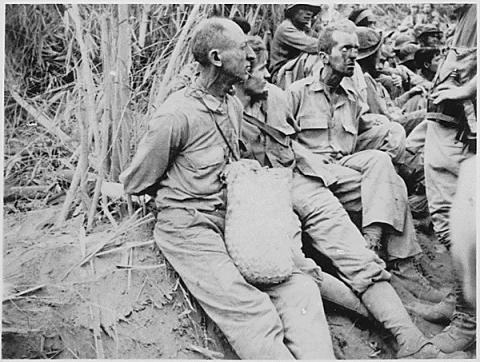On the morning of April 9, 1942, following four months of intense battle and no hopes of reinforcements, the American troops on the Bataan Peninsula of the Philippines surrendered to the Japanese. The captured American and Filipino men were then subjected to the Bataan Death March, a torturous march of more than 65 miles, in which thousands of troops died due to starvation, dehydration, and gratuitous violence. Thousands more would die in prisoner of war camps before they were liberated three years later.
American Post at Bataan
Before its formal entry into World War II, America placed defense outposts in the Philippines to protect its main Pacific possession. These outposts soon turned into one of the earliest battlefronts with Japan.
General Douglas MacArthur, newly appointed the commander of U.S. Army Forces in the Far East by President Franklin Roosevelt, ordered the American troops in the Philippines to retreat to the southern Bataan peninsula until enough reinforcements arrived. However, the attack on Pearl Harbor on December 7, 1941, interrupted the flow of reinforcements and left the troops on their own.
In the meantime, Japanese forces firmly pursued their conquest of the Philippines. Emperor Hirohito pressured his Army Chief of Staff Hajime Sugiyama twice to increase troops for a quick knockout in Bataan, describes Hirohito biographer Herbert P. Bix.
From December of 1941 to April 1942, the troops in Bataan resisted the Japanese conquest day and night. American war correspondent Frank Hewlett’s limerick would symbolize their campaign.
We’re the Battling Bastards of Bataan,
No Mama, No Papa, No Uncle Sam,
No aunts, no uncles, no cousins, no nieces,
No pills, no planes, no artillery pieces,
And nobody gives a damn!
On April 3, the Japanese flotilla originally destined for Australia arrived in the Philippines instead, and led to new surge of Japanese attacks. “There was no time during the morning, noon, or night that there was not a gunshot. Our machine guns got so hot the barrel would just curve,” Lester Tenney recalled in an interview with the Atomic Heritage Foundation in 2013.
By this time, there was a shortage of food and medicine. Reduced to less than half-rations per man, survivors recalled eating an officer’s polo pony, then even iguanas, snakes and jungle insects and plants. Malaria and dysentery also ravaged the camp, along with the non-stop noise of shelling and bombing.
On April 8, General MacArthur sent orders that the men were not to surrender. However, Major General Edward P. King, the Commanding General of the Philippine-American forces in Bataan, knew that the men were at risk of dying and defied the orders.
On April 9, 1942, the 12,000 American and 58,000 Filipino soldiers surrendered. At the time of surrender, about a third were sick or wounded, note historians Everett Rogers and Nancy Bartlit.
Death March
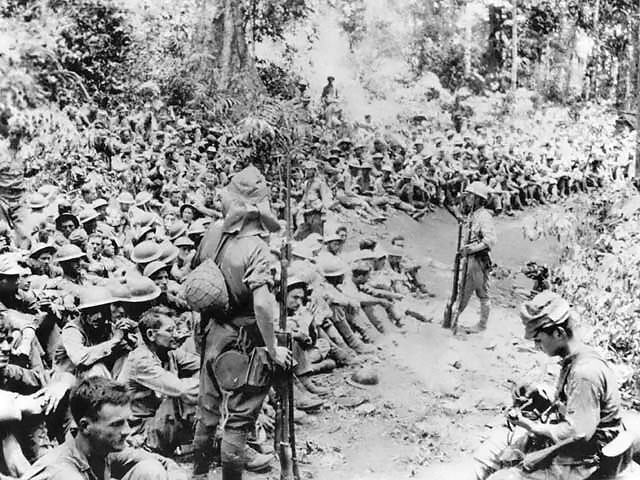 The Japanese rounded up the captured men into long columns and told them to start marching. For the next seven days, the men were forced to walk 65 miles in tropical temperatures over 100 degrees, given no food or water, and rested rarely. Over five thousand would die on the march.
The Japanese rounded up the captured men into long columns and told them to start marching. For the next seven days, the men were forced to walk 65 miles in tropical temperatures over 100 degrees, given no food or water, and rested rarely. Over five thousand would die on the march.
The Japanese military followed the Bushido code, which essentially stated that surrender was shameful and death was preferable. Anyone who surrendered was a coward and must be treated as less than human. Therefore, the recently surrendered American troops could be treated as less than human, and consequently were.
“It was called the death march, because of the way they killed you,” Tenney said. “If you stopped walking, you died. If you had to defecate, you died. If you had a malaria attack, you died. It made no different what it was; either they cut your head off, they shot you, or they bayonetted you. But you died, if you fell down.”
The Japanese soldiers who accompanied the march tortured and murdered freely. From using bayonets to prolong death to pushing bodies in front of tank paths, the Japanese would even force prisoners to stand to attention in the midday sun until some would drop of heat exhaustion.
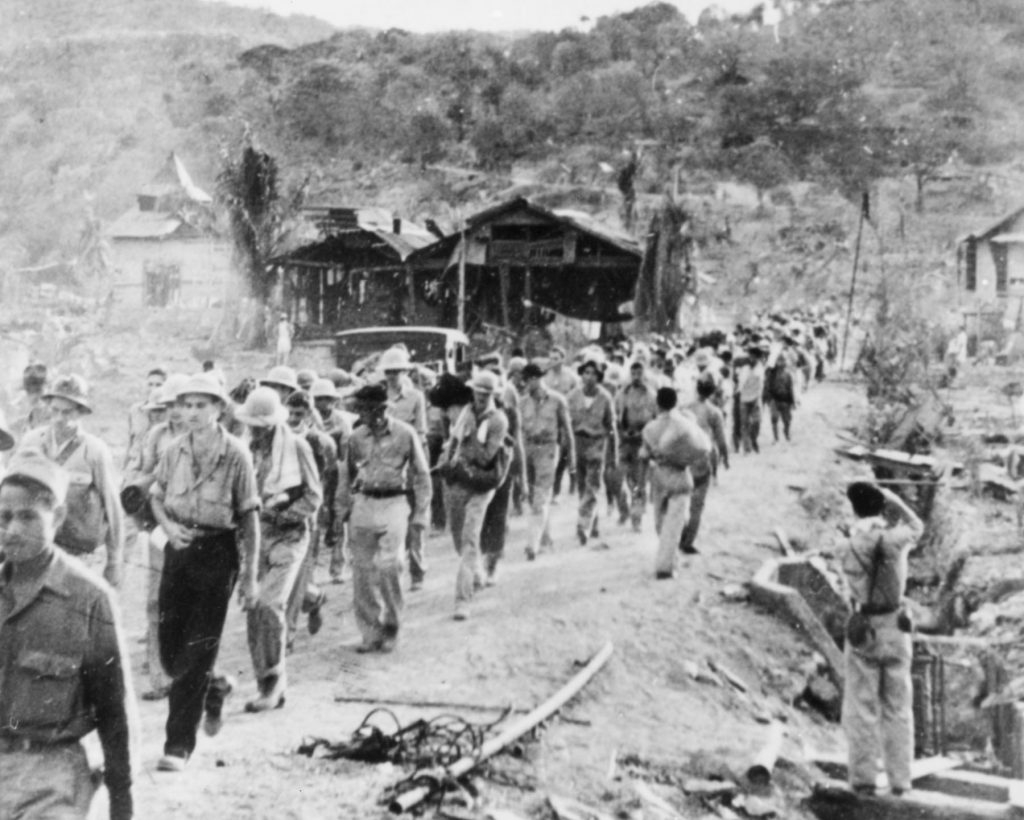
“Numerous emasculations, disemboweling, decapitations, amputations, hundreds of bayoneting, shootings and just plain bludgeoning to death of the defenseless, starved and wounded soldiers were common on the march…in full view of their helpless comrades,” said Paul Ashton, another survivor, in Rogers and Bartlit’s book, Silent Voices of World War II.
Along with death by torture, many men died of dysentery. Many artesian wells lined the path of the march, but any prisoner who tried to approach was killed. Desperation would lead men to resort to drinking whatever they could find.
Tenney recalled, “You would see water on the side of the road in carabao wallows. The carabao would sit in there and bathe. We would see that and spread the scum along the side and just drink the water. The result was dysentery, real bad dysentery.”
Following the end of the march, the prisoners were packed into hot steel boxcars with barely enough room to breathe. During this 45-mile ride, men continued to die from heat and exhaustion. Upon arrival, they marched ten more miles when they arrived at Camp O’Donnell, a former Filipino training base. “You are guests of the Emperor,” a Japanese official greeted them in English. “We will work you to death.”
Camp O’ Death
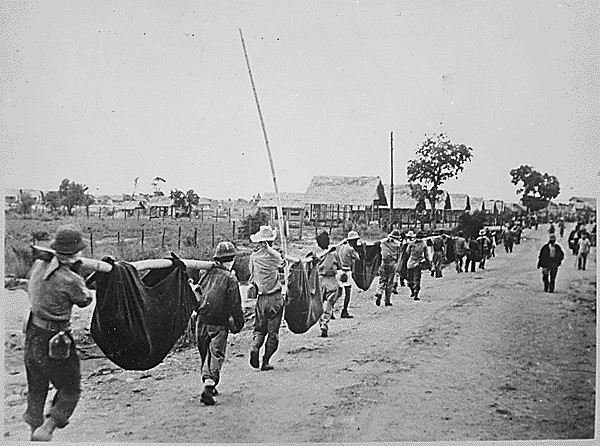
Minister of War Hideki Tojo had said, “A POW who does not work, should not eat,” which translated into a death sentence for the sick and wounded at Camp O’Donnell, explain Rogers and Bartlit. Nicknamed Camp O’ Death, the survivors of the Bataan Death march along with other POWs continued to die from starvation and disease.
The camp diet was lugao, a watery rice gruel that contained fish heads, vegetables, and usually inch-long weevils. Some POWs ate the weevils for their protein value. The prisoners supplemented their diet with prison stew, which they made from anything edible that they stole, such as turnips, or rats.
Sick prisoners were sent to the crude hospital ward, which was nicknamed “zero ward,” as in for patients with zero hope. Rogers and Bartlit describe how patients lay there and waited to die, because there was little to no medicine. One prisoner described having his appendix removed with a sharpened spoon and no anesthetic.
Escaping from the prison might have appeared to be an option, because the fence was just a couple strands of barbed wire. However, the nearest safe zone was 9,000 miles away in Australia. The prisoners did not speak the local language and “any white captive’s skin was a prison uniform he could not take off,” explained historian Gavan Daws. In addition, the Japanese implemented a system of death squads, where they created groups of ten men. If one man tried to escape, they all would be killed.
Punishments and sadistic acts continued in the prison as well. Rogers and Bartlit describe a water treatment, in which the Japanese would ram garden hoses down a prisoner’s throat or up another orifice, until the prisoner’s belly was swollen with water. Then, they would jump on the stomach. This punishment nearly always resulted in death.
Hell Ships
The prison camps in the Philippines were not the end for the dwindling number of survivors of the death march and other POWs. In May, the Japanese began transferring POWs to meet labor shortages.
Packed into “hell ships,” the prisoners barely had enough room to stand or breathe. A small canteen and bucket of rice would be occasionally lowered into the cramped hold, and these rations would be auctioned off every time a man died.
These journeys would take about a month, despite the short distance between the Philippines and mainland Japan, China, and Korea. Because the ships were unmarked, the hell ships were susceptible to enemy fire, and needed to take a convoluted route. Unfortunately, about five ships were sunk by the American navy, and about 10,000 POWs lost their lives at sea as a result.
For more on the hell ships, read here.
Labor Camps
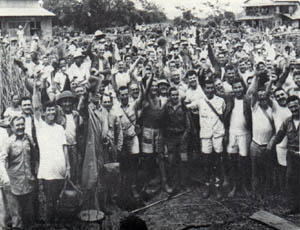 The hell ships arrived in different places, but many were destined for labor camps in Japan. At these labor camps, the POWs sometimes engaged in acts of sabotage, bending the fins of bombs and stealing food, explain Rogers and Bartlit. The cruel treatments continued as punishments included forcing two POWs to strike each other in the face until both were bloody, as well as beheadings with samurai swords.
The hell ships arrived in different places, but many were destined for labor camps in Japan. At these labor camps, the POWs sometimes engaged in acts of sabotage, bending the fins of bombs and stealing food, explain Rogers and Bartlit. The cruel treatments continued as punishments included forcing two POWs to strike each other in the face until both were bloody, as well as beheadings with samurai swords.
On August 9, 1945, some POWs witnessed the mushroom cloud from the atomic bombing of Nagasaki. One POW from Bataan, Sergeant Joe Kieyoomia, was actually in a Nagasaki prison, and survived the bombing, protected by the thick prison walls.
Following the Japanese surrender, the remaining POWs received aid as planes dropped medicine and food. Eventually they would return to the US in hospital ships, where they were permitted to eat anything they wanted. According to Rogers and Bartlit, in one navy ship, they were served rice. The POWs promptly protested and threw rice all over the ship.
Apologies and Reparations
After the war, Americans arrested Lieutenant General Homma Masaharu, the commander of Japanese troops in Philippines. He was extradited to the Philippines for the Manila war crime tribunals. He was indicted on 48 counts of violating international rules of war, including responsibility for the Death March. Although he denied involvement, he was found guilty and executed.
For more on his trial, read here.
In 1951, America signed the Peace Treaty with Japan, which included a provision waiving claims of former POWs against the Japanese government, according to historian Kinue Tokudome in an article regarding the survivors of Bataan.
In 1995, fifty years after the end of the war, Japan inaugurated the “Peace, Friendship, and Exchange Initiative”, to fund historical research and exchange programs with nations Japan had committed aggression against or dominated during World War II. As part of this exchange program, Japan invited former Allied POWs; however, American POWs were explicitly not invited due to the Peace Treaty.
Seeking justice, Bataan survivors then filed lawsuits against the Japanese companies that ran the labor camps under a newly created California law in 1999 that allowed compensation for WWII labor victims, describes Tokudome. Both the American and Japanese government sided against them, citing the Peace Treaty again. Eventually, all of the lawsuits were dismissed.
In 2007, the American Defenders of Bataan and Corregidor (ADBC), the national organization of former POWs in the Pacific, passed a resolution in their annual convention in Washington, DC, that asked for an official apology from the Japanese government. Most of the POWs at that point were in their 80s and 90s, which added to the urgency. Over the next several years, Lester Tenney, a Bataan survivor and vice commander of the ADBC, would try to meet with the Japanese Embassy.
Finally in 2010, Tenney met with the Japanese Embassy. They agreed to let American POWs make a visit to Japan and receive an apology. On Sept 13, 2010, Minister of Foreign Affairs Katsuya Okada apologized to six American POWs, including two survivors of the Bataan Death March, Tenney and Robert Rosendahl.
The POWs continued to fight for apologies from the Japanese companies that ran the labor camps as well. In 2015, in a historical moment, one of the companies that used POWs in labor camps, Mitsubishi Materials Company, apologized in a speech at the Simon Wiesenthal Center. They were the only company to apologize.
The Bataan Death March is remembered both in movies and memorials. New Mexico honors the 1,800 New Mexican soldiers who were sent to the Philippines through the Bataan Memorial Museum and an annual Bataan Memorial Death march, a 26.2-mile commemorative walk at White Sands Missile Range.





